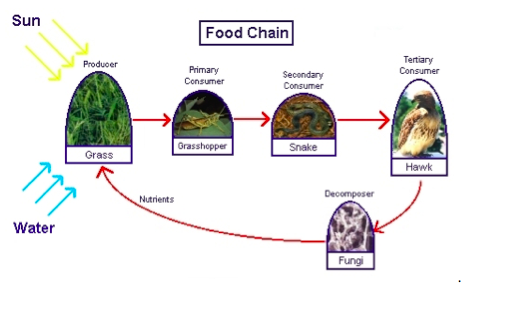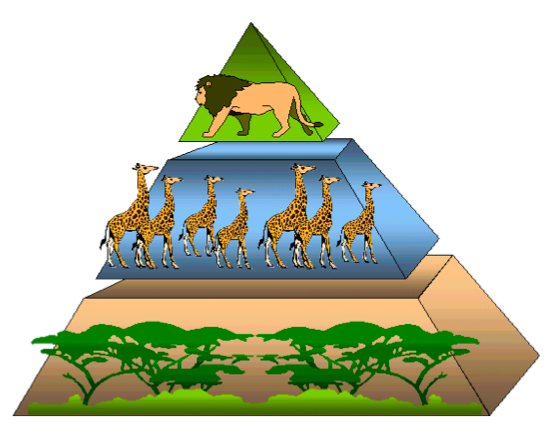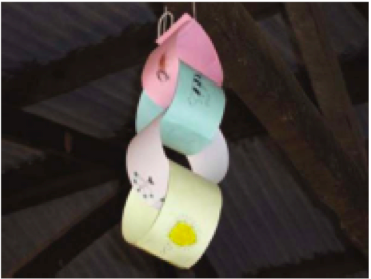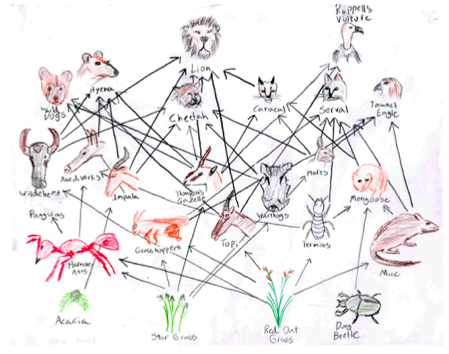Lesson 4: Food Chains
Jump To
- Big Ideas
- Essential Questions
- Content Outcomes Addressed
- Standards Addressed
- Background
- Vocabulary
- Pre- and Post-Assessment
- Misconceptions
- Investigation 1: Food Chains
- Investigation 2: Food Webs
Print this Page
Additional Resources
Big Ideas
Essential Questions
- How are organisms within the same ecosystem related to each other?
- How does what an organism eats affect its role in an ecosystem?
Content Outcomes Addressed
- Students will be able to discuss and understand that food chains can be a useful way to focus on one section of an ecosystem.
- Students will understand that food chains are one part of a food web.
- Students will be able to classify organisms based on what they eat.
Standards Addressed
NGSS:
- Disciplinary Core Ideas: LS1.C (K-2) (3-5) , LS2.A (3-5) (6-8), LS4.C (K-2)
- Science and Engineering Practices: 1, 2, 6, 7
- Crosscutting Concepts: 1, 2, 4, 5, 7
CCSS: ELA/Literacy:
- Writing: W.2.K, W.2.1
- Speaking and Listening: SL.1.K, SL.3.K, SL.5.K, SL.6.K, SL.1., SL.3.1, SL.5.1, SL.6.1, SL.1.2, SL.3.2, SL.5.2, SL.6.2, SL.1.3, SL.3.3, SL.6.3, SL.1.4, SL.3.4, SL.6.4, SL.1.5, SL.3.5, SL.6.5, SL.1.6, SL2.6, SL.5.6, SL.1.7, SL2.7, SL.5.7, SL.1.8, SL2.8, SL.5.8
National Geography Standards: 2
Background
Organisms living in an ecosystem are all connected and intertwined. Some organisms work together, with shared benefits (like honey bees aiding pollination of some flowers). More common, organisms rely on each other as a food source. A food chain shows how each living thing gets its food. Some animals eat plants and some animals eat other animals. For example, a simple food chain links the shrubs, the rabbits that eat shrubs, and the bears that eat the rabbits. Each link in this chain is food for the next link. All food chains start with energy from the sun. This energy is captured by plants. Thus the living part of a food chain always starts with plant life and ends with an animal.

Plants are called producers because they are able to use light energy from the sun to produce food (sugar) from carbon dioxide and water. Animals cannot make their own food, so they must eat plants and/or other animals. They are called consumers. There are three groups of consumers: primary, secondary, and tertiary. Animals that eat ONLY PLANTS are called herbivores and are primary consumers. Animals that eat OTHER ANIMALS are called carnivores. Carnivores that eat herbivores are called secondary consumers, and carnivores that eat other carnivores are calledtertiary consumers. Animals—including people—that eat BOTH animals and plants are called omnivores. Then there are decomposers (bacteria, fungi, and even some worms), which feed on decaying matter. These decomposers speed up the decaying process, which releases mineral salts backinto the food chain for absorption by plants as nutrients.
In a food chain, energy is passed from one link to another. When a herbivore eats, only a fraction of the energy that it gets from the plant food becomes new body mass; the rest of the energy is lost as waste or used up by the herbivore to carry out its life processes (i.e., movement, digestion, reproduction). Therefore, when the herbivore is eaten by a carnivore, it passes only a small amount of the total energy it has received to the carnivore. Of the energy transferred from the herbivore to the carnivore, some energy will be “wasted” or “used up” by the carnivore. So the carnivore has to eat many herbivores to get enough energy to grow. Because of the large amount of energy that is lost at each link in the food chain, the amount of energy that is transferred up the chain gets less and less. The higher up the food chain you go, the less food—and hence energy—remains available.
Food chains can be represented as a pyramid.

The above energy pyramid shows many trees and shrubs providing food and energy to giraffes. As we go up the food chain, there are fewer giraffes than trees and shrubs and a lot fewer lions than giraffes. This shows that as we go higher up a food chain, there are fewer and fewer consumers. In other words, a large mass of living things at the base of a food chain is required to support a few at the top. Many herbivores are needed to support a few carnivores. Most food chains have no more than four or five links. There cannot be too many links in a single food chain because the animals at the end (top) of the chain would not get enough food—and hence energy—to stay alive.
Food chains can get complicated because animals usually eat a variety of food. Most animals are part of more than one food chain and eat more than one kind of food in order to meet their food and energy requirements. When many food chains weave together, they create a food web.
Vocabulary
- food chain: a sequence of organisms arranged in such a way that each feeds on the organism below it in the chain and serves as a source of food for the organism above it
- consumers: organisms that digest other organisms as an energy source
- herbivores: organisms that only eat plant life
- carnivores: organisms that only eat meat
- omnivores: organisms that eat both meat and plant life
- decomposers: organisms that feed on carcasses of dead organisms
- food web: all the connected or linked food chains within an ecological community
Pre- and Post-Assessment
Ask students to draw a diagram of what an organism that lives nearby eats. Have students answer the following questions:
- How important is this particular organism to the ecosystem?
- What do you think would happen if this organism disappeared from the ecosystem?
Have students repeat this activity at the end of the lesson.
Misconceptions
- Food chains are the only way to talk about predator-prey relationships.
- It is all right to focus on one food source when talking about relationships between organisms.
Investigation 1: Food Chains
Focus Question
What do food chains within the ecosystems where you live look like?
Materials
- 4 strips of different colored paper for each student

- Colored pencils/markers
Procedure
- As a warm-up, have students reflect on what they have eaten in the past 24 hours. How can they classify what theyhave eaten? What type of consumer are they? Where does the food they eat come from?
- On the blackboard, write the following headings: Producers, Primary Consumers, Secondary Consumers, and Tertiary Consumers. Ask students to name some species under each heading.
- Draw lines connecting different organisms to demonstrate one food chain, or path of consumption.
- Using the strips of colored paper, each student will create his/her own food chain. Have students draw the sun and a producer on the first strip of colored paper, a primary consumer on the second, a secondary consumer on the third, and a tertiary consumer on the fourth strip. The strips of different colored paper should then be interlocked and glued together in the order in which consumption occurs, as shown in the picture.
Discussion
After completing the activity, ask students to reflect on the following questions:
- How many different food chains did the students make?
- How many of the food chains contain organisms that consume the same organisms? (e.g., bears and rabbits both eat berries)
- What is missing from the food chains? (decomposers and the variety of things the organismseat)
- Are the food chains connected in any way?
End Product/Assessment
Hang the food chains around the classroom.
Investigation 2: Food Webs
Focus Question
How can we accurately depict and discuss the consumption relationships between different organisms in an ecosystem? This activity will show how a food web is made up of several food chains.
Materials
- Index cards
- Ball of yarn
- Pieces of yarn
Procedure
- Start by putting these five headings on the board: Producers, Primary Consumers, Secondary Consumers,Tertiary Consumers, Decomposers. Have students name species under each heading and tell something about the lifestyle of each species. Then have each student choose a species from the board, write its name on an indexcard, and draw a picture of the species on the card. (As a species is chosen, put a check beside the name on the board to make sure the species is only used once.)
- Begin the food web by having one student serve as the sun. Have the students who drew producers bring their cards up. Have the sun hold a piece of yarn for each of the producers, with the producer students holding onto the other end of the yarn. Then have students who drew primary consumers bring their cards up. They should hold a piece of yarn connecting them to each of the producers they consume. One at a time, discuss which producers each primary consumer would eat.
- Next have students with cards showing secondary and tertiary consumers come up. Discuss the connections between primary, secondary, and tertiary consumers. Each secondary consumer will have a piece of yarn that is connected to a herbivore; each tertiary consumer will have a piece of yarn connected to a carnivore.
- Next add decomposers—bacteria, fungi, worms, and other organisms that feed on decaying matter. Discuss their role in the food web and use yarn to connect them to their food sources. Students should now have a complete understanding of how a food web is made up of many interconnected food chains. Below is an example of a food web.
- Stand on something tall to take an overhead picture of the food web the students have created.
- Have students individually drop their pieces of yarn. What is affected by the loss of a decomposer? A tertiary consumer? A secondary consumer? A producer?

Discussion Questions
- Why do you think there are more herbivores than carnivores?
- What if one organism from the food chain disappeared? What about one level of the food chain? Producers? Decomposers? Herbivores?
- How do humans fit in the food chain?
- What could happen if an organism not native to an area is brought into the local food chain?
- How can sun and rain affect the food chain? Drought?
- Why is a food web a more accurate depiction of nature than a food chain or pyramid?
Extension
Have students draw a 2-D depiction of the food web the class created. What shape does it take? For homework, have students draw a food web of a different ecosystem.
